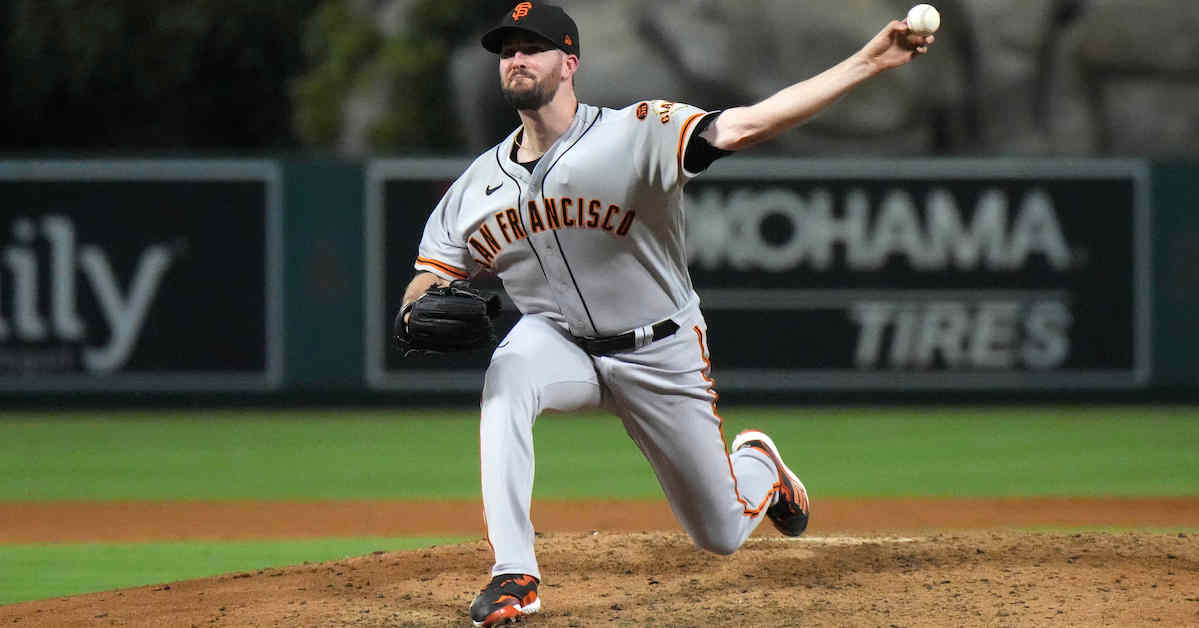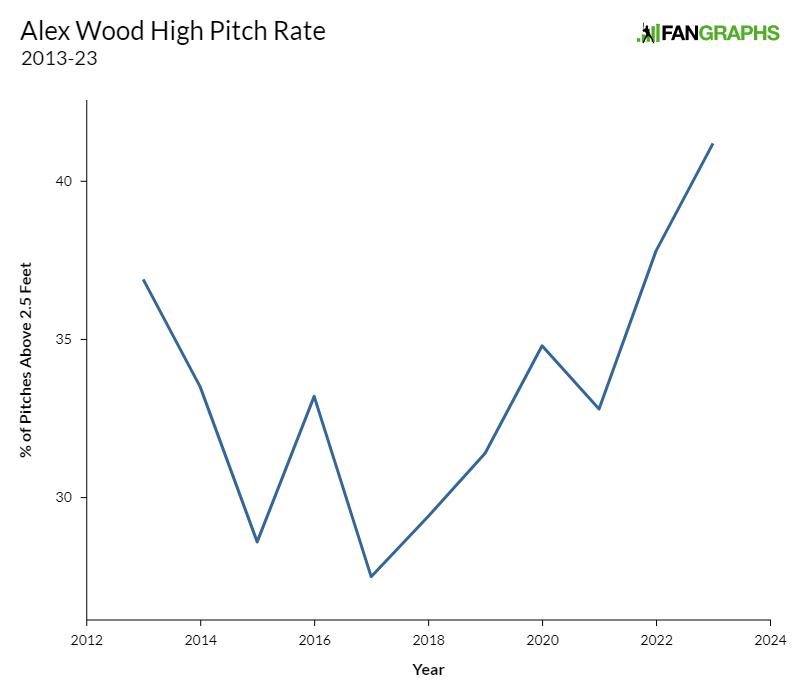
Kirby Lee-USA TODAY Sports
We’ve spent a fair deal of time the past few months discussing the AL West, producers of the past two World Series winners. There’s the reigning champion Rangers constructing a pitching staff built for next October, the always-potent Astros assembling a mega-bullpen to go along with their core of offensive talent, and the Mariners making a whole lot of trade as part of their perpetual roster churn. Each of these three teams won at least 88 games last year, and all three had a shot at the division crown entering the final weekend of the regular season. Their offseason moves reflect their hopes to contend again in 2024.
The same cannot be said for the two other teams in the division. The Angels spent most of the offseason bolstering their bullpen while doing nothing to fill the Ohtani-sized hole in their lineup. The 112-loss Athletics did even less. They signed reliever Trevor Gott, traded for Abraham Toro, and that’s about it. That is, until a few days ago, when Oakland signed lefty Alex Wood and Los Angeles added outfielder Aaron Hicks. The two players improve their new clubs along the margins, but it’s going to take more than them to turn things around.
Alex Wood Moves Across the Bay
Wood, 33, agreed to a one-year deal with Oakland over the weekend, though the terms of the contract have not yet been reported. He began his career as a highly effective starter on the Braves and Dodgers, posting a 3.29 ERA and 3.36 FIP through his first six seasons. Since then, he’s been more up and down. After injuries limited him to nine appearances combined in 2019 and 2020, he took a prove-it deal with the Giants on their miracle 2021 squad, parlaying a bounceback campaign into a two-year, $25 million contract, which didn’t work out as well. Wood had a 4.77 ERA across the two seasons and was nearly replacement level in 2023, looking nothing like the mid-rotation arm he once was.
Wood’s struggles in the first year of his second contract with the Giants were largely the product of batted ball luck; he outperformed his peripherals by about a run and a half. While his numbers in 2023 returned to nearly league-average levels, the under-the-hood numbers took a big turn for the worse. Take a look at his three-year run in San Francisco.
Alex Wood’s Giants Tenure
| Season |
O-Swing% |
K% |
BB% |
SIERA |
| 2021 |
32.2% |
26.0% |
6.7% |
3.60 |
| 2022 |
33.5% |
23.6% |
5.4% |
3.45 |
| 2023 |
28.9% |
17.2% |
9.8% |
4.98 |
The numbers in 2021 and 2022 look remarkably similar, despite a vastly different ERA. But nearly everything fell apart last year. The drop in strikeout rate is significant, but what stands out most to me are the elevated walk rate and plummeting chase rate, signs of a loss in command. Part of the issue may be mechanical; Wood dropped his arm slot significantly upon joining the Giants, and his funky delivery almost resembles a shotput throw rather than a baseball pitch. But between 2022 and 2023, his vertical release point stayed about the same while his arm got about two inches less horizontal extension.
In terms of actual pitch locations, Wood often missed his spots high. I’m not just talking about intentionally-placed flat sinkers; his slider and changeup also had a generally upward drift – not an ideal outcome for someone who uses the lateral action on each of his offerings to induce ground balls. Indeed, last year he had the worst grounder rate of any full season in his career. These frequent misses made it easier for batters to lay off pitches just below the zone, an area where Wood has frequently generated value in the past, leading to a ballooning of his walk rate.

This signing is as much about Wood’s role as it is about his performance. A career starting pitcher, Wood was frustrated last year when the Giants made him a swingman. San Francisco’s decision to break down the traditional roles of starter and reliever gave jobs to rookie arms like Keaton Winn and Tristan Beck, but staff veterans certainly had to adapt to the unorthodox change. Wood averaged less than four innings a game in his dozen starts, while making relief appearances of between one and 15 outs. On one occasion, he tossed four innings and 70 pitches the day after a bullpen session and on short rest from his previous appearance.
Luckily for Wood, the A’s are the perfect team for a veteran to attempt a comeback in a consistent role. He joins fellow low-slot lefty JP Sears as the only members of the projected rotation to ever complete 120 innings in a big league season. The presence of “relative innings eaters” like Sears, Wood, and Paul Blackburn (who has topped at 111 innings) will allow a pair of young arms with big stuff in Luis Medina and Joe Boyle to pitch full seasons in the rotation with minimal risk of being overworked. They’ll also help take the load off Mason Miller, who touches 102 mph and projects as a top-five reliever by Steamer, but has spent the bulk of his professional career on the injured list. With this signing, both sides gain some stability, and if Wood pitches well, the A’s could trade him to a contender before the year is over. In the meantime, though, Wood gets a team willing to give him the ball every fifth day, while Oakland gets a live breathing man willing to pitch on a bleak-looking squad – the smallest of win-wins.
Aaron Hicks Comes to Anaheim
Once an everyday center fielder who received an MVP vote in 2018, Hicks has taken quite the fall from grace in recent years. He signed a seven-year deal worth $70 million with the Yankees after his ’18 campaign, when his combination of solid home run power and a disciplined approach made him a four-win player. But his subsequent issues with injuries and performance have sapped his value, and in May, he was released with nearly three years left on his contract. He played out the rest of 2023 with the Orioles and had a surprising return to form, though he did this in just a 65-game sample and outperformed his expected numbers considerably. The Yankees will now be paying Hicks over $8 million to play for the Angels as he attempts to rebuild his career.
First, there’s the health aspect of things. The season that prompted Hicks’ lengthy extension is, to date, the only time he’s qualified for the batting title, thanks to a laundry list of injuries that have afflicted pretty much every body part there is. These issues have had a considerable impact on his performance, most notably seen in his steady decline in power over the past half decade. Since his best season, his maximum exit velocity has declined by 4 mph, and his barrel and hard-hit rates have cratered. As someone who’s never excelled at spraying line drives, Hicks isn’t able to rely on soft flares that land in front of outfielders.
A switch hitter, Hicks tapped into his power with New York because of his ability to pull the ball in the air, a skill aided by the juiced ball era and Yankee Stadium’s short porch for left-handed hitters. The Yankees as a whole were successful in optimizing the batted ball profiles of many of their hitters, turning DJ LeMahieu and Didi Gregorius into 25-homer threats. During the peak juiced ball years of 2018 and ’19, Hicks hit nearly all of his homers to the pull side, especially taking advantage when stepping into the box as a lefty. Since then, his aerial contact has been considerably weaker. Combine that with a baseball that behaves in line with normal physics, and his entire source of power disappeared. From 2017-19, Hicks homered every 22 plate appearances; that rate has been slashed nearly in half over the past four seasons. Hicks is still likely a near-average hitter, but that value will be exclusively coming from his still-great walk rates, not through homers.
Exit Velocity on Line Drives and Fly Balls
| Season |
Exit Velocity |
| 2018 |
93.3 |
| 2019 |
94.6 |
| 2020 |
93.2 |
| 2021 |
94.7 |
| 2022 |
92.1 |
| 2023 |
90.0 |
SOURCE: Baseball Savant
The addition of Hicks, now 34, complicates the Angels’ outfield situation a bit. They already have two clear everyday outfielders in Mike Trout and Taylor Ward, leaving just one spot and a fraction of DH time for Hicks, Mickey Moniak, and Jo Adell. Even without Hicks in the picture, allocating playing time is still a challenge. On a contending team, it would make sense to set up Moniak and Adell in a power-heavy (and OBP-light) platoon. But the Angels aren’t in such a situation. Rather, they should be prioritizing the out-of-options Adell in their plans, either to build up trade value or to give him a last chance at being a viable everyday player. Now with Hicks, a veteran and known quantity who can also be traded, in the picture, the playing time picture gets squeezed a bit more.
Because of the team’s outfield logjam, Hicks probably won’t see tons of playing time to start the year. But he certainly provides a much-needed insurance policy if things don’t go as planned. He can play center field if Trout gets injured or a corner if Moniak or Adell are waived or traded. And the positional shuffling in the case of an Anthony Rendon injury could open up time at DH for him to fill. Hicks certainly shouldn’t be stealing playing time, but especially at his price point, the Angels will be glad to have him if (or when) things go wrong.
Source
https://blogs.fangraphs.com/two-veterans-sign-with-the-non-contenders-of-the-al-west/
 Backyard GrillingWeekend WarriorsAdvice from DadBeard GroomingTV Shows for Guys4x4 Off-Road CarsMens FashionSports NewsAncient Archeology World NewsPrivacy PolicyTerms And Conditions
Backyard GrillingWeekend WarriorsAdvice from DadBeard GroomingTV Shows for Guys4x4 Off-Road CarsMens FashionSports NewsAncient Archeology World NewsPrivacy PolicyTerms And Conditions
